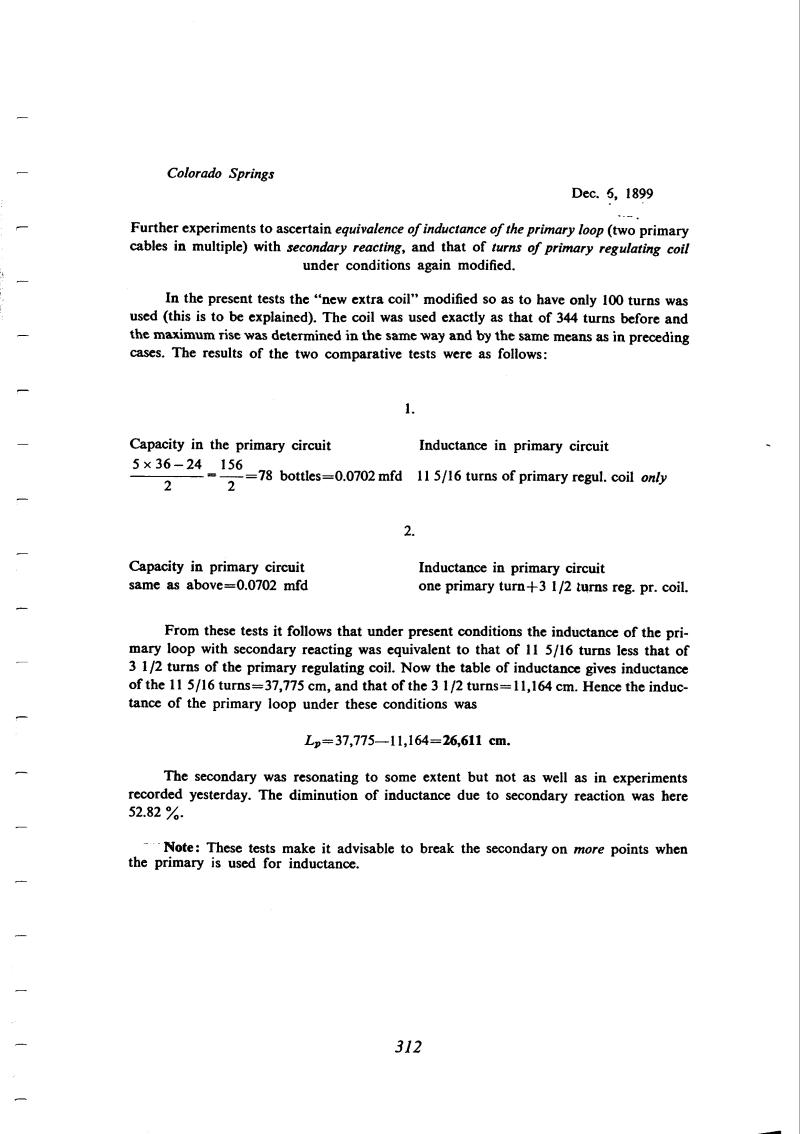
Nikola Tesla Books
Colorado Springs
Dec. 6, 1899
Further experiments to ascertain equivalence of inductance of the primary loop (two primary cables in multiple) with secondary reacting, and that of turns of primary regulating coil under conditions again modified.
In the present tests the ânew extra coilâ modified so as to have only 100 turns was used (this is to be explained). The coil was used exactly as that of 344 turns before and the maximum rise was determined in the same way and by the same means as in preceding cases. The results of the two comparative tests were as follows:
| 1. | |
| Capacity in the primary circuit | Inductance in primary circuit |
| $! {{5 \times 36 - 24} \over 2} $! = $! {156 \over 2} $! = 78 bottles = 0.0702 mfd | 11 5/16 turns of primary regul. coil only |
| 2. | |
| Capacity in primary circuit same as above = 0.0702 mfd |
Inductance in primary circuit one primary turn + 3 1/2 turns reg. pr. coil. |
From these tests it follows that under present conditions the inductance of the primary loop with secondary reacting was equivalent to that of 11 5/16 turns less that of 3 1/2 turns of the primary regulating coil. Now the table of inductance gives inductance of the 11 5/16 turns = 37,775 cm, and that of the 3 1/2 turns = 11,164 cm. Hence the inductance of the primary loop under these conditions was
Lp = 37,775 - 11,164 = 26,611 cm.
The secondary was resonating to some extent but not as well as in experiments recorded yesterday. The diminution of inductance due to secondary reaction was here 52.82%.
Note: These tests make it advisable to break the secondary on more points when the primary is used for inductance.
312
December 6
The photographs of the inside of the laboratory show the 100-turn âextra coilâ raised above the floor in the center. With this coil Tesla again got similar results for the âreducedâ inductance of the primary. However, aware of the indeterminacy of this âreductionâ, and hence also of the oscillation frequency, he notes that the secondary should be broken at more points when the primary is used as a measuring inductance. This would ensure monochromatic oscillation of the oscillator by reducing the coupling of the primary and secondary (i.e. the circuit of the âextra coilâ). The measurements with the secondary eliminated are more reliable, and the accuracy with which the values sought are determined depends mainly on the accuracy to which the inductance and capacitance in the exciting circuit of the oscillator are known.
December 6
Further measurements on "reduced primary inductance" Tesla continues on Dec. 6 with a changed circuit for resonance indication. Instead of a coil with 344 turns, he puts "additional coil" with 100 turns of significantly bigger dimensions. This coil is seen on photographs of the inside of Tesla's laboratory as a central coil positioned above the ground. With this coil he achieves similar results for ''reduced'' primary inductance. However, aware of undefined amount of ''reduction'' and with this undefined operating oscillating frequency, Tesla emphasized that the secondary has to be interrupted at several locations when the primary inductance is used as a measurement inductance. By such procedure Tesla secured the required conditions for the mono-frequency oscillator operation, because now the primary and secondary circuit (i.e., ''additional coil'' circuit) are poorly coupled. When the secondary is eliminated the measurement results are more reliable than from those in which the secondary existed and the accuracy of determining the required values mainly depends on knowledge of accuracy of inductance and capacitance in the excitation oscillator circuit.

